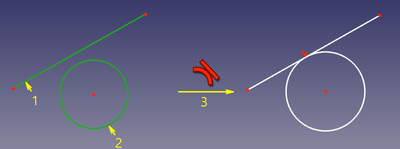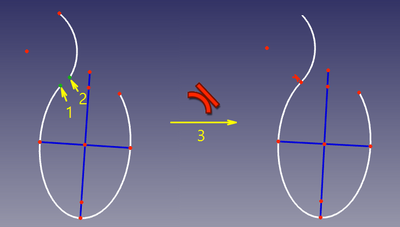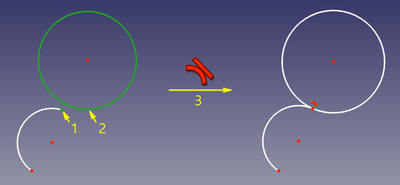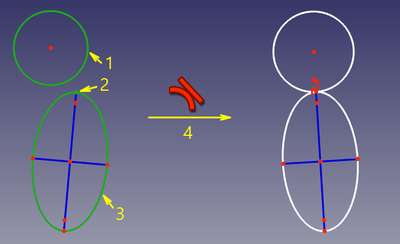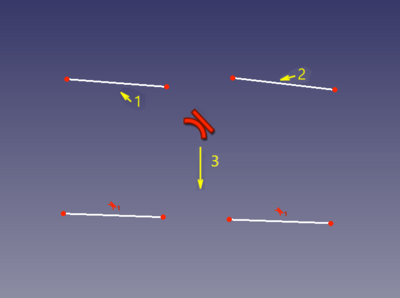Sketcher ConstrainTangent: Difference between revisions
No edit summary |
|||
| (28 intermediate revisions by the same user not shown) | |||
| Line 16: | Line 16: | ||
{{GuiCommand |
{{GuiCommand |
||
|Name=Sketcher ConstrainTangent |
|Name=Sketcher ConstrainTangent |
||
|MenuLocation=Sketch → Sketcher constraints → Constrain tangent |
|MenuLocation=Sketch → Sketcher constraints → Constrain tangent or collinear |
||
|Workbenches=[[Sketcher_Workbench|Sketcher]] |
|Workbenches=[[Sketcher_Workbench|Sketcher]] |
||
|Shortcut={{KEY|T}} |
|Shortcut={{KEY|T}} |
||
|SeeAlso= |
|||
|SeeAlso=[[Sketcher_ConstrainPointOnObject|Sketcher Constraint point on object]] |
|||
}} |
}} |
||
| Line 25: | Line 25: | ||
<!--T:2--> |
<!--T:2--> |
||
The [[Image:Sketcher_ConstrainTangent.svg|24px]] [[Sketcher_ConstrainTangent|Sketcher ConstrainTangent]] tool constrains two edges, or an edge and an axis, to be tangent. Lines are treated as infinite, and |
The [[Image:Sketcher_ConstrainTangent.svg|24px]] [[Sketcher_ConstrainTangent|Sketcher ConstrainTangent]] tool constrains two edges, or an edge and an axis, to be tangent. Lines are treated as infinite, and open curves are virtually extended as well. The constraint can also connect two edges, forcing them to be tangent at the joint. If two lines are selected, or a line and the endpoint of another line, the lines are made collinear. |
||
==Usage== <!--T:30--> |
==Usage== <!--T:30--> |
||
See also: [[Sketcher_Workbench#Drawing_aids|Drawing aids]]. |
|||
| ⚫ | |||
# Make sure there is no selection. |
|||
| ⚫ | |||
#* Press the {{Button|[[Image:Sketcher_ConstrainTangent.svg|16px]] [[Sketcher_ConstrainTangent|Constrain tangent or collinear]]}} button. |
|||
| ⚫ | |||
| ⚫ | |||
| ⚫ | |||
| ⚫ | |||
# Do one of the following: |
|||
#* Select two edges. The edges can be any edge except a B-spline. |
#* Select two edges. The edges can be any edge except a B-spline. |
||
| ⚫ | |||
| ⚫ | |||
# A Tangent constraint is added. If a point and two edges have been selected, up to two [[Sketcher_ConstrainPointOnObject|Point on object constraints]] can also be added. See [[#Between_two_edges_at_point|Examples]]. |
|||
| ⚫ | |||
| ⚫ | |||
===Run-once mode=== |
|||
# Do one of the following: |
|||
| ⚫ | |||
#* Select two endpoints belonging to different edges. |
#* Select two endpoints belonging to different edges. |
||
#* Select an edge and the endpoint of another edge (in any order). |
#* Select an edge and the endpoint of another edge (in any order). |
||
#* Select a point and two edges (idem). |
#* Select a point and two edges (idem). |
||
# Invoke the tool as explained above, or with the following additional option: |
|||
| ⚫ | |||
#* |
#* {{Version|0.22}}: Right-click in the [[3D_view|3D view]] and select the {{MenuCommand|[[Image:Sketcher_ConstrainTangent.svg|16px]] Constrain tangent or collinear}} option from the context menu. |
||
# A Tangent constraint is added. If a point and two edges have been selected, up to two [[Sketcher_ConstrainPointOnObject|Point on object constraints]] can also be added. See [[#Between_two_edges_at_point|Examples]]. |
|||
| ⚫ | |||
| ⚫ | |||
| ⚫ | |||
| ⚫ | |||
| ⚫ | |||
| ⚫ | |||
| ⚫ | |||
| ⚫ | |||
| ⚫ | |||
| ⚫ | |||
==Examples== |
==Examples== |
||
===Between two edges |
===Between two edges=== <!--T:5--> |
||
</translate> |
</translate> |
||
| Line 55: | Line 67: | ||
<translate> |
<translate> |
||
The two edges are made tangent. If one of the edges is a [[Sketcher_Workbench#Sketcher_CompCreateConic|conic]], a [[Sketcher_CreatePoint| |
The two edges are made tangent. If one of the edges is a [[Sketcher_Workbench#Sketcher_CompCreateConic|conic]], a [[Sketcher_CreatePoint|Point object]] that has a [[Sketcher_ConstrainPointOnObject|Point on object constraint]] with both (extended) edges is added. |
||
<!--T:8--> |
<!--T:8--> |
||
It is not recommended to reconstruct the point of tangency by manually creating a point and constraining it to lie on both curves. It will work, but the convergence will be seriously slower, jumpier, and will require about twice as many iterations to converge than normal. If the point of tangency is needed, select two edges and an existing point instead. |
It is not recommended to reconstruct the point of tangency by manually creating a point and constraining it to lie on both curves. It will work, but the convergence will be seriously slower, jumpier, and will require about twice as many iterations to converge than normal. If the point of tangency is needed, select two edges and an existing point instead. |
||
===Between two endpoints |
===Between two endpoints=== <!--T:9--> |
||
</translate> |
</translate> |
||
| Line 66: | Line 78: | ||
<translate> |
<translate> |
||
The endpoints are made coincident, and the angle between the edges at that point is set to 180° (smooth) or 0° (sharp), depending on the placement of the edges before the constraint is applied. |
The endpoints are made coincident, and the angle between the edges at that point is set to 180° (smooth joint) or 0° (sharp joint), depending on the placement of the edges before the constraint is applied. |
||
===Between edge and endpoint |
===Between edge and endpoint=== <!--T:12--> |
||
</translate> |
</translate> |
||
| Line 75: | Line 87: | ||
<!--T:13--> |
<!--T:13--> |
||
The endpoint of one edge is constrained to lie on the other edge, and the edges are made tangent at that point. |
|||
<!--T: |
===Between two edges at point=== <!--T:15--> |
||
'''Accepted selection:''' |
|||
* line, circle, arc, ellipse, arc-of-ellipse + endpoint of line/arc/arc-of-ellipse (i.e., any curve + endpoint of any curve) |
|||
===Between two edges at point (tangent-via-point)=== <!--T:15--> |
|||
</translate> |
</translate> |
||
| Line 89: | Line 96: | ||
<!--T:16--> |
<!--T:16--> |
||
The two edges are made tangent at a given point. The point can be any point, e.g. the center of a circle, the endpoint of an edge, or the origin, it can belong to one of the edges, and it can also be a [[Sketcher_CreatePoint|Point object]]. If required [[Sketcher_ConstrainPointOnObject|Point on object constraint(s)]] are added to ensure the point lies on both (extended) edges. These additional constraints are called [[Sketcher_helper_constraint|helper constraints]]. |
|||
In this mode, two curves are made tangent, and the point of tangency is tracked. This mode is applied when two curves and a point were selected. |
|||
<!--T:17--> |
|||
'''Accepted selection:''' |
|||
* any line/curve + any line/curve + any point |
|||
"Any point" can be a lone point, or a point of something, e.g. a center of a circle, an endpoint of an arc, or the origin. |
|||
<!--T:18--> |
|||
For the constraint to work correctly, the point must be on both curves. So, as the constraint is invoked, the point will be automatically constrained onto both curves ([[Sketcher_helper_constraint|helper constraints]] will be added, if necessary), and the curves will be forced tangent at the point. These [[Sketcher_helper_constraint|helper constraints]] are plain regular constraints. They can be added manually, or deleted. |
|||
<!--T:19--> |
<!--T:19--> |
||
Compared to direct tangency, this constraint is slower, because there are more degrees of freedom involved, but if the point of tangency is needed, it is |
Compared to direct tangency, this constraint is slower, because there are more degrees of freedom involved, but if the point of tangency is needed, it is recommended because it offers better convergence. |
||
<!--T:20--> |
|||
The placement of the point before the constraint is applied is a hint for the solver for where the tangency should be. With this constraint, one can constrain two ellipses to touch each other in two places. |
|||
===Between two lines |
===Between two lines=== <!--T:32--> |
||
</translate> |
</translate> |
||
| Line 111: | Line 107: | ||
<translate> |
<translate> |
||
The two lines are made collinear. |
|||
<!--T:33--> |
|||
'''Accepted selection:''' |
|||
* any line/vertex + any line/vertex |
|||
==Scripting== <!--T:21--> |
==Scripting== <!--T:21--> |
||
Revision as of 07:50, 19 April 2024
|
|
| Menu location |
|---|
| Sketch → Sketcher constraints → Constrain tangent or collinear |
| Workbenches |
| Sketcher |
| Default shortcut |
| T |
| Introduced in version |
| - |
| See also |
| None |
Description
The Sketcher ConstrainTangent tool constrains two edges, or an edge and an axis, to be tangent. Lines are treated as infinite, and open curves are virtually extended as well. The constraint can also connect two edges, forcing them to be tangent at the joint. If two lines are selected, or a line and the endpoint of another line, the lines are made collinear.
Usage
See also: Drawing aids.
Continue mode
- Make sure there is no selection.
- There are several ways to invoke the tool:
- Press the
Constrain tangent or collinear button.
- Select the Sketch → Sketcher constraints →
Constrain tangent or collinear option from the menu.
- introduced in version 0.22: Right-click in the 3D view and select the Constrain →
Constrain tangent or collinear option from the context menu.
- Use the keyboard shortcut: T.
- Press the
- The cursor changes to a cross with the tool icon.
- Do one of the following:
- Select two edges. The edges can be any edge except a B-spline.
- Select a point and two edges (in that order).
- Select an edge, a point and another edge (idem).
- A Tangent constraint is added. If a point and two edges have been selected, up to two Point on object constraints can also be added. See Examples.
- Optionally keep creating constraints.
- To finish, right-click or press Esc, or start another geometry or constraint creation tool.
Run-once mode
- Do one of the following:
- Select two edges (see above).
- Select two endpoints belonging to different edges.
- Select an edge and the endpoint of another edge (in any order).
- Select a point and two edges (idem).
- Invoke the tool as explained above, or with the following additional option:
- introduced in version 0.22: Right-click in the 3D view and select the
Constrain tangent or collinear option from the context menu.
- introduced in version 0.22: Right-click in the 3D view and select the
- A Tangent constraint is added. If a point and two edges have been selected, up to two Point on object constraints can also be added. See Examples.
Examples
Between two edges
The two edges are made tangent. If one of the edges is a conic, a Point object that has a Point on object constraint with both (extended) edges is added.
It is not recommended to reconstruct the point of tangency by manually creating a point and constraining it to lie on both curves. It will work, but the convergence will be seriously slower, jumpier, and will require about twice as many iterations to converge than normal. If the point of tangency is needed, select two edges and an existing point instead.
Between two endpoints
The endpoints are made coincident, and the angle between the edges at that point is set to 180° (smooth joint) or 0° (sharp joint), depending on the placement of the edges before the constraint is applied.
Between edge and endpoint
The endpoint of one edge is constrained to lie on the other edge, and the edges are made tangent at that point.
Between two edges at point
The two edges are made tangent at a given point. The point can be any point, e.g. the center of a circle, the endpoint of an edge, or the origin, it can belong to one of the edges, and it can also be a Point object. If required Point on object constraint(s) are added to ensure the point lies on both (extended) edges. These additional constraints are called helper constraints.
Compared to direct tangency, this constraint is slower, because there are more degrees of freedom involved, but if the point of tangency is needed, it is recommended because it offers better convergence.
Between two lines
The two lines are made collinear.
Scripting
Tangent Constraint can be created from macros and from the Python console by using the following:
# direct tangency
Sketch.addConstraint(Sketcher.Constraint('Tangent',icurve1,icurve2))
# point-to-point tangency
Sketch.addConstraint(Sketcher.Constraint('Tangent',icurve1,pointpos1,icurve2,pointpos2))
# point-to-curve tangency
Sketch.addConstraint(Sketcher.Constraint('Tangent',icurve1,pointpos1,icurve2))
# tangent-via-point (plain constraint, helpers are not added automatically)
Sketch.addConstraint(Sketcher.Constraint('TangentViaPoint',icurve1,icurve2,geoidpoint,pointpos))
where:
Sketchis a sketch objecticurve1,icurve2are two integers identifying the curves to be made tangent. The integers are indexes in the sketch (the value, returned bySketch.addGeometry).pointpos1,pointpos2should be 1 for start point and 2 for end point.geoidpointandpointposinTangentViaPointare the indexes specifying the point of tangency.
The Sketcher scripting page explains the values which can be used for incurve1, incurve2, pointpos1, pointpos2, geoidpoint and pointpos and contains further examples on how to create constraints from Python scripts.
- General: Create sketch, Edit sketch, Map sketch to face, Reorient sketch, Validate sketch, Merge sketches, Mirror sketch, Leave sketch, View sketch, View section, Toggle grid, Toggle snap, Configure rendering order, Stop operation
- Sketcher geometries: Point, Line, Arc, Arc by 3 points, Circle, Circle by 3 points, Ellipse, Ellipse by 3 points, Arc of ellipse, Arc of hyperbola, Arc of parabola, B-spline by control points, Periodic B-spline by control points, B-spline by knots, Periodic B-spline by knots, Polyline, Rectangle, Centered rectangle, Rounded rectangle, Triangle, Square, Pentagon, Hexagon, Heptagon, Octagon, Regular polygon, Slot, Fillet, Corner-preserving fillet, Trim, Extend, Split, External geometry, Carbon copy, Toggle construction geometry
- Sketcher constraints:
- Geometric constraints: Coincident, Point on object, Vertical, Horizontal, Parallel, Perpendicular, Tangent, Equal, Symmetric, Block
- Dimensional constraints: Lock, Horizontal distance, Vertical distance, Distance, Radius or weight, Diameter, Auto radius/diameter, Angle, Refraction (Snell's law)
- Constraint tools: Toggle driving/reference constraint, Activate/deactivate constraint
- Sketcher tools: Select unconstrained DoF, Select associated constraints, Select associated geometry, Select redundant constraints, Select conflicting constraints, Show/hide internal geometry, Select origin, Select horizontal axis, Select vertical axis, Symmetry, Clone, Copy, Move, Rectangular array, Remove axes alignment, Delete all geometry, Delete all constraints
- Sketcher B-spline tools: Show/hide B-spline degree, Show/hide B-spline control polygon, Show/hide B-spline curvature comb, Show/hide B-spline knot multiplicity, Show/hide B-spline control point weight, Convert geometry to B-spline, Increase B-spline degree, Decrease B-spline degree, Increase knot multiplicity, Decrease knot multiplicity, Insert knot, Join curves
- Sketcher virtual space: Switch virtual space
- Additional: Sketcher Dialog, Preferences, Sketcher scripting
- Getting started
- Installation: Download, Windows, Linux, Mac, Additional components, Docker, AppImage, Ubuntu Snap
- Basics: About FreeCAD, Interface, Mouse navigation, Selection methods, Object name, Preferences, Workbenches, Document structure, Properties, Help FreeCAD, Donate
- Help: Tutorials, Video tutorials
- Workbenches: Std Base, Arch, Assembly, CAM, Draft, FEM, Inspection, Mesh, OpenSCAD, Part, PartDesign, Points, Reverse Engineering, Robot, Sketcher, Spreadsheet, Surface, TechDraw, Test Framework
- Hubs: User hub, Power users hub, Developer hub
